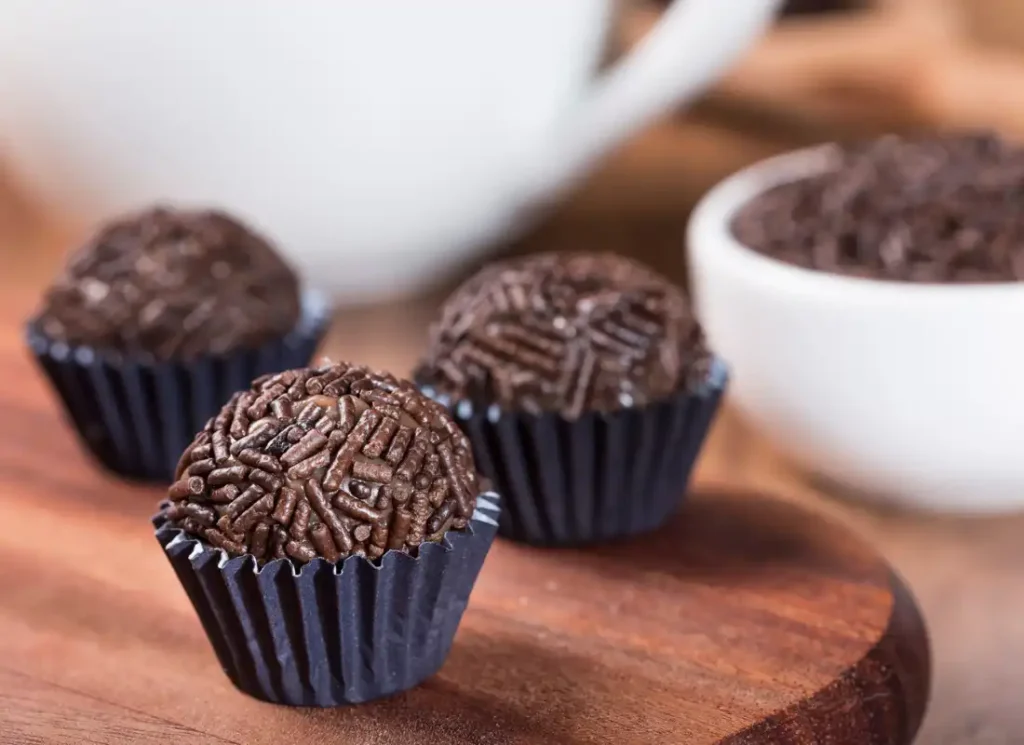This week Zsófi is talking about what is Brigadeiro, how it became such an iconic Brazilian dessert, and best of all: gives you the homemade Brigadeiro recipe she learned on the streets of São Paulo.
My Brazilian Adventure
Let me paint you a picture. 2014. Wardrobes filled with skater skirts and knee-high socks. Teenagers ironically memorising the infamous dance moves to Psy’s Gangnam Style. Celebrities spilling buckets of ice cold water on each other in support of ALS. Hundreds of thousands of eyes glued to the screen as Germany scores yet another goal against Brazil in that unforgettable match.
And little me? Well, she was just getting ready to travel 10,000 kilometres from Miskolc in the northeast of Hungary to the not-very-famous-but-all-the-more-special-for-it town of Assis in southeastern Brazil. As a tiny 15-year-old, I signed up for an exchange programme which gave me the opportunity to spend three months living with a host family in Brazil, attend school, and embrace the true brasileira life.
My summer in Brazil was more than just a holiday in the sun. It was yellow and green jerseys with Neymar’s name printed on them. It was eating meat skewers fresh off the barbecue to the excited shouts of the World Cup-watching uncles. It was all the miraculous mornings when I could dress in shorts and skirts even though it was supposedly the middle of winter. It was repeating ‘eu não falo português’ over and over until it became untrue. It was caipirinhas and henna tattoos.
It was discovering Brazilian food for the first time. The fresh fruit in the morning, the beans and rice, lettuce and beef for lunch, the pork and bean stew for dinner. The pizzas, but all of them Brazilian-style, richly topped with sausage, ham, peppers, sweetcorn, and even cream cheese! Or, and brace yourself, the sweet pizzas, prepared with chocolate, dulce de leite, or bananas (probably my biggest culture shock).
It was the treats in between meals that, for me, always came in the form of a pão de queijo, a light cheese puff that perfectly filled the gaping hole in your stomach after a long and strenuous day of lying on the sofa. Even the raw sugar cane my host family dared me to try while parked awkwardly on the side of a country road on our way home. I still remember the taste: sweet, of course, yet surprisingly refreshing.
Back to our World Food section
A Little Bit About Brazilian Food
Brazilian food is hard to define in just one word, and if I had to, I would choose the word diverse (is that cheating?). This cuisine is marked by a fusion of indigenous, West African, and Portuguese culinary traditions with influences from Japanese and other South American countries. Considering the remarkable size of the country and the approximately 217 million people that reside in it, the Brazilian food culture boasts an extensive internal variety.
There is nothing the Northeast region of Brazil, with its hot, tropical climate and wonderful beaches, does better than seafood. If you ever find yourself in Salvador or Recife, you must try moqueca, a famous prawn and coconut milk stew. My favourite northeastern delight, however, is not the seafood (yes, still a vegetarian), but a light, flaky, pancake-like dish called tapioca. Tapiocas are made from tapioca flour and are perfect for breakfast or a light lunch. They can be consumed with both savoury or sweet toppings; my favourite was always a classic chocolate and banana. (Is this where my bubble tea obsession comes from? We’ll never know.)
Northern Brazil’s cuisine is defined largely by the Amazon forest and river. This region has been historically isolated from Portuguese settlers and foreign influences which gave way for indigenous culinary traditions to persist. Freshwater fish are very popular here, as well as the raw ingredients of the forest and the many nourishing fruits of the Amazon. Maracuya and açaí are just two of the fantastic fruits grown locally in Northern Brazil that make an appearance on every breakfast table. It’s no surprise they have become the faces of a health craze in the Western world.
Indigenous fruit also makes up a large portion of a Brazilian diet in the Center-West. Pequi is especially popular here with its citrusy flavour that pairs perfectly with some chicken or rice. Furthermore, most livestock is based in this region so meat is especially important here.
As we are arriving in the South of Brazil, we are getting closer and closer to the birthplace of a, if not the, Brazilian institution: Brazilian barbecue, aka the churrasco. If you think a churrasco is like any other barbecue, you are sorely mistaken. A Brazilian churrasco is a whole day affair all about the music, the beer, the flavours of the meat, and the heat of the fire as it becomes indistinguishable from that of the Sun. I have many fond memories from churrasco weekends, and if you ever get invited to one, I urge you to say yes without hesitation.
And finally, the Southeastern region, home to that wonderful town of Assis, but perhaps better known for the cities of Rio de Janeiro, São Paulo, and Minas Gerais. As the country’s three most populous cities all inhabit this region, it is really Southeastern food that has become the spearhead for Brazilian food worldwide.
The national dish of feijoada, for example, originates from Rio de Janeiro. This warm stew is packed with beans, pork belly, sausages, and really, every other type of meat you can imagine. It is utterly delicious and unmissable. If you are a fellow herbivore, however, don’t panic! Shiitake mushrooms imitate the texture of the pork so perfectly, you will not miss out on this fantastic gastronomic experience.
World Food: Best Soups from Around the World
What is Brigadeiro?
It is clear now that Brazilian food culture is varied. It’s not afraid to season generously, to use the raw ingredients of the landscape, to pack as many flavours as it can onto one plate. It is full of fresh ingredients and healthy goodness while being hearty and filling at the same time. But one more thing needs to be said about the Brazilians: they REALLY know their desserts. I could mention many examples here but I believe I only need to mention one: brigadeiro.
This chocolate truffle goodness dates back to post World War II Rio, more specifically to the landmark elections of 1945. Not only were these the first democratic elections following the dictatorial regime of Getúlio Vargas, but these were also the first elections in which women were allowed to vote (well, married women with their husband’s permission, single women with their own salary, or widows, but let’s not dampen the mood). Political candidates were using all methods available to them to charm their voters and sway the results in their favour.
In the midst of this democratic fervour, one of the candidates, former military brigadier (yes, this will be important later) Eduardo Gomes was desperate to get his well-deserved seat. This desire, together with his creative mind, resulted in the important lightbulb moment in which he decided to create a new confectionery item to gain the support other, more boring candidates, were acquiring by means of speeches and rallies. This dessert was named brigadeiro, pronounced bree-gah-day-roh, after his military title.
However, creating a new sweet treat off the back of the War and the food shortages that it brought with it was no easy task: fresh milk at the time was a rare sight, and condensed milk was the widely used replacement. Nowadays, brigadeiro is famous for its chewy texture and incredible sweetness, all thanks to the use of condensed instead of fresh milk. While unfortunately, Gomes did not succeed in winning the elections, his name is forever immortalised in one of Brazil’s most delicious contributions to the world.
Brigadeiro is made only with three ingredients: butter, condensed milk, and cocoa powder. The cooking method, if indeed we dare call it cooking, involves mixing the melted butter, condensed milk and cocoa powder and leaving the mixture to cool until it’s firm. After that, you have two choices, if you want to go for aesthetics, you may opt for shaping the mixture into little balls and covering them in chocolate sprinkles. Most shops and patisseries will sell brigadeiro in this form.
A less pretty but more efficient way of consuming this sweet, however, is pouring the mixture into a container of any kind (really, any tupperware will do), and spoon it straight out like you would Nutella out of the jar.
World Food: What are Shaved Ice Desserts?

How to Make Brigadeiro
Brigadeiro Ingredients
1 tin of condensed milk (395g)
1 spoonful of butter
30g cocoa powder
Chocolate sprinkles for decoration (optional)
Brigadeiro Method
Brigadeiro is incredibly simple to make. Put a medium-sized pot on a low heat and mix the melted butter, condensed milk, and cocoa powder with a wooden spoon or spatula until your mixture becoms doughey in texture. There is one simple rule here: if you think you have been mixing for enough time now and you can stop, keep going. The mixture should be already thick and resembling cookie dough by the time you take it off the hob. I cannot tell how long this will take exactly as it always depends on the heat and the ratio of the ingredients. However, for me, it was the full length of the All Too Well (10 Minute Version) (Taylor’s Version) and the full length of I Bet You Think About Me (Taylor’s Version).
After the mixture is the desired texture, and only then, pour it onto a plate that had been previously greased with butter. Now, all you have to do is let it cool. You can do this at room temperature, but this will take a long time. For a speedier process, I would recommend putting it into the fridge. Or better yet, stick it in the freezer for about 25 to 30 minutes and you’ll get to enjoy your dessert just a little bit earlier.
Once the mixture is cool, take it out and start rolling little brigadeiro balls. Take about one spoonful of the mixture, roll it into a ball, cover it in chocolate sprinkles and repeat the process as many times as your ingredients allow.
Bom apetite!

